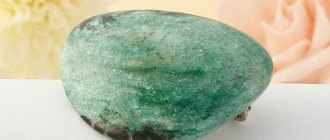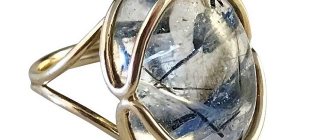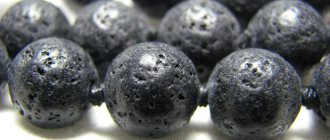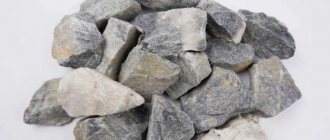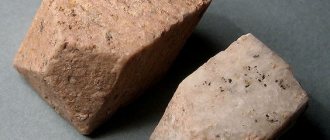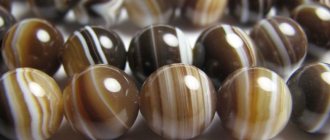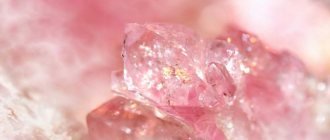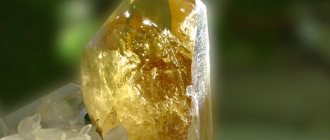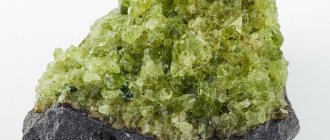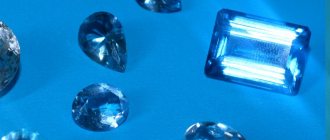Amethyst, rock crystal, rauchtopaz, morion, citrine, heliotrope are just a few examples of quartz varieties. There are a lot of natural reserves of quartz crystals. However, it is still counterfeited. Imitations of quartz are suitable for inexpensive jewelry, but in the case of precious jewelry, the seller is simply obliged to tell the buyer the whole truth about the product. However, this information is often kept silent.
Natural rose quartz
Myths and legends about the mineral
In ancient times, people believed that an unusual pink pebble appeared on earth with the light hand of the goddess of love. Even then, he was credited with the ability to help in resolving amorous affairs, considering him a talisman of lovers for both men and women.
In addition, people managed to appreciate the special properties of quartz and believed that the mineral could give beauty and youth. The raw mineral was turned into quartz chips and added to cosmetic products for the skin of the face and body.
Easterners have a special relationship with pink pebbles. Since ancient times, they believe that the mineral helps create an atmosphere of peace, comfort and family happiness in the house. Following the laws of Feng Shui, representatives of Eastern civilizations always find a place for crafts at home, hang quartz pictures, install figurines and a bonsai tree made of quartz, which is popular in the East.
Mineral formation
Quartz has the property of crystallizing in different modifications. It all depends on the conditions under which the substrate for the reaction, that is, silica, is located. Most often, the substance crystallizes from acidic magma. Pegmatites grow together with feldspar and form a quartz core. If the process is hydrothermal in nature, the result is crystal veins.
At the same time, the stone is stable in surface deposits and placers of various origins. This fact explains that the stone is often found on river banks or beaches in crushed form or in the form of full-fledged crystals.
Properties and description of the mineral: what it looks like in nature
Look what the photo of the stone looks like. The stones are characterized by a milky pink color and glassy luster. On the hardness scale, the mineral has a rating of 7 points, with a density of 2.6 g/cm3.
Today, three types of quartz are mined:
- star-shaped;
- cat's eye with shimmer;
- translucent with white veins.
Each is beautiful and unusual in its own way, but the star mineral looks especially bright in jewelry. It is this that creates the effect of magic, if it is a fortune telling ball made of quartz or a pyramid made of natural stone as a decorative element. It is mainly used by Pandora to create exclusive jewelry and jewelry.
Features of caring for natural quartz
This mineral is both hard and brittle. It is suitable for making most jewelry, but requires careful use and storage. To ensure that stone products remain beautiful, you should follow several rules:
- protect the gem from impacts to avoid chipping and scratches;
- keep away from sunlight to prevent or slow fading;
- wash off dirt with a soapy water solution;
- Do not use ultrasonic devices or steam cleaners for cleaning.
Elegant but not timeless
For all its popularity, rose quartz cannot be considered ideal, if only because if the wearing conditions are not met, the stone can eventually lose its unusual color. Initially, jewelers warn future owners of rose quartz jewelry to store them in a cool place and avoid prolonged contact with UV rays.
The thing is that the color and special magic of the stone are nothing more than the characteristics of the chemical composition based on the admixture of titanium ions to silicon oxide. An increase in temperature provokes a change in the charge of the ions and leads to a malfunction of the titanium atoms, which begin to transmit light through the array. The result is loss of color at extremely high temperatures and a decrease in intensity even with minimal doses of heat.
Types of quartz[edit]
Crystalline quartz[edit]
Usually transparent and translucent, painted in all the colors of the rainbow.
- Aquaaurite
(from “aqua” - water and “aur” - aurum, gold). Dislocation of the brain. The thinnest layer of gold is sprayed onto quartz, then it becomes like aquamarine: it acquires a rich blue-green hue, which changes noticeably depending on the viewing angle. Don't ask me why this is necessary. Just a beautiful brand. - Herkimer Diamonds
, also
Diamonds
. Small quartz crystals of high purity and clarity, quarried in Herkimer County, New York. A completely ordinary rock crystal, not much different from any other, but for some reason they have gained particular popularity among those who believe in the magical properties of stones. - Rock crystal
. Crystal is simply a type of glass with a high lead content. Rock crystal is a pure, colorless and transparent variety of quartz. Before the invention of rhinestones, they were used as a substitute for more expensive transparent stones, mainly diamond. Transparent rock crystal was popular in optics of past centuries as a substitute for the then imperfect glass. Known for its thermal conductivity: you can safely pour boiling water into a samovar and a glass made of rock crystal, but the glass one will burst. Nowadays it is mainly used by all sorts of fortune tellers and sorcerers in the form of a crystal ball - an attribute of witchcraft. After an inexpensive process for the synthesis of rock crystal was invented, natural crystal finally became just a cheap decorative stone. Even sculptures are made from synthetic rock quartz! A special chic of recent years: tableware made of synthetic rock crystal, resistant to damage and temperature changes. Not every synthetic glass will hold up. It also looks better than glass. - There are also quartz filters for water and, oddly enough, light.
- a purple variety of quartz. Densely colored crystals are most prized. Our Ural amethysts are very densely colored and change color from violet to purple depending on light sources.
- The myth “amethyst is a stone of sobriety” is not confirmed by any serious historical research. I suspect that this is just a historical tale. In addition, amethyst can be dark, which does not fit well with diluted wine.
- an attempt to disguise it as a more expensive stone: verdelite - green tourmaline, less often emerald. All green amethysts are created from ordinary low-grade pale amethysts by heating and sometimes baking. Don’t even think about blurting out in front of a mineralogist that there are natural “green amethysts”! You can't collect the bones!
. Quartz, sometimes colored like amethyst, sometimes like citrine. Plays whimsically with a variety of colors. Popular brand. Keep in mind that cheap technology for the synthesis of ametrine has now been developed, and natural stones rarely hit the shelves.
is another mineral that does not exist in nature. In fact, quartz colored blue with inclusions of dumortierite occurs in nature, but it is cloudy and not decorative. Pure and transparent synthetic blue quartz usually imitates topaz and aquamarine in cheap jewelry.
, also known as “rauchtopaz”, is a trademark, an attempt to disguise it as a more expensive brown topaz. From pale gray with barely noticeable clouds of natural dye through brown to almost black. The color is rarely deep brown, usually greyish. Dark rauchtopaz stones are often used as raw materials for refining. Back in the 18th century. Russian craftsmen baked them in bread and obtained deep orange citrines (“dumplings”). Now almost all smoky quartz is refined through heating and becomes a rich, even brown; This is how jewelry inserts are made.
| Hairy |
- Quartz-hairy
, “hairy” aka “Hair of Venus”, “Cupid’s Arrows”. Not to be confused with "sunstone". Quartz with inclusions of rutile, which has a bright diamond luster. The rutile needles shimmer and play in the light; they are interesting to look at. Usually, “hairy” means citrine with golden rutile, but it can also be quartz with the inclusion of shiny black rutile, and even amethyst with the inclusion of golden rutile - such a stone is called “onegit” in honor of Eugene Onegin.
| Red quartz |
- Strawberry quartz aka strawberry quartz
. It appeared three years ago, was discovered by chance in the mines of Kazakhstan. It is quartz with hematite flakes, which give it a characteristic pinkish-red or orangish-red color, similar to the color of ripe strawberries. The hematite flakes inside the stone shimmer brightly and shine like red sparks. You won’t find real strawberry quartz during the day; on the shelves they usually sell glass Chinese (Made in China) imitation made of bubbly laminated glass, painted scarlet pink. The author of the edit, living in Omsk, which is next to Astana, had the honor of looking at real Kazakh strawberry quartz. The glass imitation does not even remotely resemble the original. - Morion
. Opaque black, translucent brown in thin plates. Previously used in mourning jewelry. Nowadays it is not used in jewelry; it has been replaced everywhere by black spinel. Morion is covered in bad legends and is considered the stone of drug addicts and those who are tormented by nightmares. Common urban myths. - Praz
. Quartz has a rare green color due to impurities of foreign minerals. Not decorative, unlike prasiolite. - Rose quartz
. A cloudy, fractured variety of quartz. Fades quickly in the sun. It can be asterical (“stars” with six rays), and brightly colored rose quartz with clear stars will be the crown jewel of a mineralogical collection. In jewelry, it is usually not quartz itself, but synthetic quartz with a pink dye, presumably based on Mn (manganese). Such synthetics are extremely transparent and do not fade in the sun. - Citrine
is a yellow variety of quartz. It is replaced by more expensive golden topazes and heliodors. Natural citrines are usually pale in color: light yellow, light yellow-green, pale orange, peach. Bright orange and chartreuse green (“acid” color) quartz is obtained from smoky quartz.
Chalcedony[edit]
Translucent to opaque, rarely monochromatic. The origin is hydrothermal. They are painted in all colors from pale to rich, only blue is rarely seen. Chalcedony may change color slightly when in contact with water and absorb it, this is normal. Keep them away from dyes; they simply absorb them.
- Actually chalcedony
. Usually translucent solid gray, white, pale green. Nondescript. - Agates
. Usually pale colored chalcedony with weak zoning. Agates have countless varieties, differing in structure and color. They are great for small carved trinkets. Agates clearly show how the stone grows and changes over time. Some mineral collectors specialize only in agates.
| Sapphirine |
- Blue chalcedony
aka “sapphirine”. The latter term also refers to the separate mineral sapphirine Mg7Al18Si3O40, so it is better not to use it. Regular pretty milky blue, milky lilac chalcedony with ring stripes. Its transparent jewelry variety without stripes is called the same and is more purple than blue. Jewelry chalcedony is often tinted, because natural stones are of dull colors. - Detroit agate, Detroit agate, fordite
. Has nothing to do with agates. Old hardened paint for cars, originally of the Ford brand, and then of others, vaguely reminiscent of layered agate. - Prazem
. Also green, but cloudy and opaque, usually olive and dirty green shades. It looks a lot like jade and differs in structure. An ordinary ornamental stone, for some reason domestic jewelers don’t like it. - Carnelian
, carnelian, lincurium, sardonyx. A series of translucent chalcedony of similar colors. Carnelian is a meat-red chalcedony. Carnelian (sard) - orangeish and orange-yellow. Lincurium is pale yellow. Sardonyx is white with orange stripes. Usually they are all called “carnelian”. The author of the article in his hometown of Omsk during World War II, due to a shortage of medicines, underwent carnelian therapy, based on supposedly weak radioactive radiation from the mineral. The authorities then threw out all the documents and did the right thing: carnelian has no special properties. Just a beautiful stone with an optimistic orange color. Although the author of the article has a geologist friend who treats his old bones with carnelian and claims that it helps him. A schizotechnical carnelian fan is included.
aka eye quartz. In antiquity, eyes were imitated in statues. They differ from agates by the sharply expressed difference between the layers and their concentricity. All kinds of carved multi-color cameos are still made from onyx, a good material.
- T.n. The green or yellowish "onyx" often used in small carvings, goblets, etc. is actually common calcite with a hardness of 3.0. Everything would be fine if it weren’t covered with varnish on top.
. Bright green, blue-green, emerald chalcedony. The natural color is moderately resistant, fades from extreme dryness and heat, and is restored in a damp and cold place. Transparent, evenly colored, without visible inclusions, is especially valued; it is considered a 3rd order gemstone and is often confused with emerald and imperial jadeite. The remaining cloudy chrysoprase are ordinary ornamental stones of group 1. 90% of the chrysoprase on the shelves is created from ordinary dyed gray chalcedony. Painted stones are simply visible to the naked eye; their paint forms a cobweb pattern and is unevenly distributed.
. Chalcedony with a high content of foreign impurities. Jasper comes in different varieties. The author of the edit can remember offhand three dozen names for different types of jasper, differing in color. You can find jasper for every taste, including the most sophisticated. Jasper is a good ornamental mineral, due to its strength it retains a flawless polish for a long time. It can be used to make stone mosaics, statues, and furniture. I don’t recommend making a bath from jasper; it will be cold and slippery.
- Irminite
is the rarest blue jasper, colored with azure (lapis lazuli). In fact, it is not deep blue, but bluish-gray with blue zones. It is found throughout the world in the form of individual blocks. A good collectible.
. Green or blue-green jasper with red flecks, mostly hematite. Considered a symbol of the sacrificial blood of Jesus. Popular with Catholics, nothing else notable.
Opals[edit]
| (link) The glow of black opal |
There is no color that opal cannot catch and retain, including even modern bright ones like magenta and cyan. Traditionally, opals are divided into noble white, black and ignoble of all kinds of colors. Well-known opals with a bright multi-colored shine are noble ones. The ignoble ones do not have any iridescence, but they come in unexpectedly rich colors: dark blue, grass green, blue-green.
| (link) The brilliance of white opal |
Opal is much less hard than quartz: 5.5 - 6.5 points on the Mohs scale.
All opals, being silica-based, contain some amount of water. Without it, they dry out and crack, losing all their decorative properties. Dry heat (and usually in city apartments the air is very dry) and direct sunlight are destructive for them. It is advisable to occasionally immerse all opals in water for a couple of hours once a month if you do not have a cool, damp place to store them. The opal is also impregnated with the individual sweat secretions of the owner and from this acquires its special color. It is important to keep them away from dyes: they will absorb. Household chemicals, including soap, are extremely harmful to opal.
- Black opal
. He's not black, watch the video. This is the name for opals with a dark gray or blue base, on which bright reflections of various colors are especially clearly visible. Such beauty is worthy of 1 group of precious stones. - White opal
. The same opal, but paler, therefore it is included in group 2 of precious stones. The base is usually pale blue or pale green-blue, and the glitter is also bluish-green. - Fire opal
. Red, orange, deep yellow. Without opalescence, i.e., color shifts. Usually cloudy, the best examples are transparent. This type of opal is diamond-cut or otherwise cut for clear gemstones and is often set into gold items. Included in group 2 of precious stones. It is interesting for its internal play of color - no other mineral has this. - Hyalite
. A stone with an unexpected effect. When dry, it is transparent, without shimmer - but once you put it in water, it will sparkle with all its colors! Capable of absorbing water four times its weight, but dries out very quickly. Very fragile. It is considered an ornamental stone of group 1. Hyalite usually looks like glass that imitates moonstone, i.e. its overall color is bluish, but when exposed to light it is yellow. - Cahalong
. A transitional option between opal itself and chalcedony. Usually snow-white or slightly yellowish, maybe with black streaks. Brittle and porous. Ordinary ornamental stone. - Fossils of organic remains replaced by opal. Sometimes they are even replaced by noble opal. Whether this should be considered a museum exhibit or a precious item is still being debated. Usually large replacements go to the museum, and small ones from something common go to exotic souvenirs. Dinobon
, literally dinosaur bone. A type of opal that replaced the bones of prehistoric reptiles. - Wood opal
from petrified wood.
Rose quartz: where is it mined?
The main deposits of the mineral are in Brazil, but it is also mined in Karelia, as well as in Altai, in the USA, even Madagascar quartz is found. Depending on the place of extraction, the stone has one or another color intensity. In the photo you can see that it can be either a soft pink stone, reminiscent of the first rays of the rising sun, or minerals of a bright, saturated almost red color.
Use of stone
Archaeologists find the most ancient rose quartz jewelry in Mesopotamia. Their age is about 7000 years. In the east, the mineral was worn as an amulet to attract love. In ancient Rome and Greece, it was ground to make an anti-aging cream. In ancient times, they believed that the gem was given to people by the god of love, Cupid. Later, this mineral was widely used in Florence to create mosaics.
In the modern world, the stone is in great demand among jewelers. The color of the mineral and some of its unique properties make it possible to make a variety of jewelry. It is very often set in white gold or platinum; the crystal goes well with silver. The cut is carried out cabochon.
Product prices
Inexpensive beautiful stones
Rose quartz jewelry is suitable for any woman, regardless of age. The cost largely depends on the design of the jewelry and the metal from which the frame is made. The variety, color of rose quartz crystal and its cost are correlated. Translucent and star-shaped specimens are always more expensive than milky ones. Samples with the “cat's eye” effect are considered expensive. The gem belongs to the middle price category. The exception is Madagascar, its value is close to precious stones.
Jewelry with this mineral is inexpensive. For example, a pendant without precious metal can be bought for 400-800 rubles. Earrings will cost 500-1000 rubles. Beads - 1000-2000 rubles, and a rose quartz bracelet - 500-1000 rubles.
Silver and gold items are more expensive. A ring with a crystal set in gold can cost from 12,000 to 100,000 rubles, depending on the design and manufacturer. Gold earrings will cost 15,000-50,000 rubles. The necklace will cost about 30,000-120,000 rubles. Products made of white gold and high-grade metal are always more expensive.
Rose quartz and the price of the stone in silver jewelry are slightly lower. The pendant will cost about 6,000-12,000 rubles, the ring – 5,000-10,000 rubles. Earrings can be bought for 4000-1000 rubles. How much you pay for a piece depends on the sterling silver, weight and design of the piece.
How much does quartz cost?
Despite its exclusive color and sophisticated appearance, rose quartz is not an expensive mineral, although examples of it can be found in gold and silver jewelry. Several kilograms of stone can be bought for only 10-20 dollars. Individual specimens of unusual shape, size or shade are sold at a higher price.
In general, the cost of a stone depends on the degree of its uniqueness and cut. For example, the most affordable option is gold jewelry with a quartz cabochon. But a special cut based on symmetrical and equal rhombuses and squares significantly increases the cost of the mineral and the product in which it was used.
Jewelry (necklaces, bracelets, rings, pendants or earrings) with pink minerals often look extraordinary and original. You should be wary when the pink stone is deliberately given a secondary role, trying to distract attention with details. In this case, it makes sense to think about imitation quartz. Perhaps instead of the original, they are trying to sell ordinary tinted glass or plastic at its price.
Detailed description of the appearance of natural quartz
The mineral is extremely beautiful: it has delicate muted shades and a varied structure. Each copy is unique and endowed with individuality.
Rose quartz is a rare stone.
Stone structure
Unlike other types of quartz, the pink type has a hexagonal type macrocrystalline structure, which makes it look like a stone with a heterogeneous composition. It is fragile, so there are many chips and cracks on its surface and inside. Most samples contain inclusions of foreign substances.
How to distinguish a fake from the original
The value of rose quartz is not in its high cost or even in its color. Natural stone has special magical and healing properties, on which the owner rightly places certain hopes. In order not to buy a fake instead of a real mineral, it is worth knowing about the simple differences between the original and the copy. Usually, artificial quartz, even of good quality, can be easily identified by the following signs:
- air bubbles inside the stone;
- insufficient hardness (scratched by sharp objects);
- too smooth edges and special smooth bends of the holes in the beads;
- perfect uniform color.
They most often try to replace rose quartz with the so-called “Cherry quartz” - pink glass. In appearance, the imitation is noticeably different from the original. It is easy to scratch, air bubbles are clearly visible inside. Natural rose quartz is easy to distinguish by its cloudy color with harmonious shade transitions, light cleavage lines and the absence of inclusions of a different color. In addition, a natural mineral will always be slightly heavier than a fake.
Varieties
Based on their structure, minerals are divided into two groups: crystalline and cryptocrystalline. The first includes crystals that resemble hexagonal pencils, and the second is quartz whose structure cannot be seen without a magnifying glass due to the heterogeneous coating. There are more than 20 varieties of the mineral, but we will list only the most popular of them:
- Transparent. It is valued more than others because it does not contain other impurities. It is used to create jewelry due to its high hardness, shine and transparency. Stone appears in rock voids.
- White. It can only be split with a special device; otherwise this is impossible due to its hardness. It is used for industrial purposes because it is not destroyed by acids or alkalis.
- Tourmaline. Quartz is unique in its appearance. It is transparent, has a slightly darkened color and thin piercing stripes. Due to the contrast, the mineral looks impressive.
- Green. It has a dense structure and contains nickel silicates. The glass shine and rich color make it unique.
- Rainbow. Its appearance resembles the radiance of a rainbow. Previously, it was used for mystical rituals. But in fact, this appearance is due to air bubbles, water and light refraction.
- Rutile. Inside it there are many small stripes (rutile inclusions). The thinner these lines are, the higher the stone is rated. The main shade is red, yellow, white or blue.
- Smoky. It has a gray-brown or black tint. When heated, it turns into noble citrine and is valued even more.
- Opal. Due to its unique composition, it has different colors and is considered a cryptocrystalline substance. There are noble and fiery types. Its structure hides water, air bubbles and small cracks.
Magical properties of pink mineral
Like any natural stone, rose quartz has special magical properties. The mineral is believed to be a symbol of love, joy and good luck. With his help, people understood how to clean and heal the wounds of the heart and soul, forgive and believe in good things.
How long can it take for soul healing with quartz? There is no exact answer. For some, the effect will become noticeable after weeks, and for others, after years. The main thing is to be ready to perceive yourself as new through tears and forgiveness of past grievances. Only in this way, having freed yourself from everything that pressed from within and prevented you from spreading your wings, will you be able to move on to a new stage of life, where every day and every minute will give joy.
A small pink pebble or a comfortable quartz rosary is recommended for anyone who wants to change their life for the better. Together with the mineral, it will be easier to get rid of negative experiences, accept and love yourself, and get a mindset of happiness.
Despite its innocent appearance, rose quartz has a real ability to open the soul, teaches you to love yourself and give love to others. The stone helps to get rid of stress, cope with outbursts of anger, awakens creativity in everyone and helps to foster a sense of self-confidence.
The correct spell for pink quartz helps to find happiness in a love relationship. Helps men become bolder and more courageous, protects women during pregnancy, gives strength and mood, helps to find a faithful life partner.
Differences between artificial and natural materials
Stores often offer customers fakes that are not worth the money. The easiest way to tell quartz from glass is to scratch it with a sharp object. There will be no marks left on the natural material, but the fake will quickly deteriorate. A gem always has a colder surface, this can be felt when touching the product.
In addition, the natural mineral has some defects, since perfect quartz does not occur in nature. The synthetic product heats up much faster, even in the sun. They also differ in weight; glass is always lighter. You can verify the crystalline structure if you place the mineral in water, it will be able to refract light, but a fake will not.
Ritual to attract love with quartz
Once you believe in the special power of the stone, you should turn to it every time it is important to adjust your personal life. How to charge rose quartz for love? Take it step by step.
So, to carry out a ritual to attract love into your life, you will need jewelry with a pink quartz stone. It doesn’t matter what it will be: a pendant, ring, earrings or beads. The main thing is that the mineral is genuine (read above how to distinguish a fake). At night, the product is placed in water with a spoon of salt and left on the windowsill.
It is important that the decoration is completely immersed in water. After a day, when the stone has absorbed the light of the sun and moon, the water is poured out and the decoration itself is washed under running water. This is a preliminary procedure to cleanse the mineral of negative energy. After its completion, they move on to the actual ritual.
To attract happy love into life, the ritual is performed on the day of the full moon. A love plot is read over a piece of jewelry with quartz, ending with a request to mother Venus for love.
Morion
The most unusual example of quartz is morion, or black quartz. It does not transmit light through itself, unless it is cut into thin slices. It is almost impossible to reproduce such crystals artificially.
Morion
Don’t forget to also ensure that the price of the product matches its type. And also conduct a spectral analysis in the laboratory if the above verification methods do not convince you of the authenticity of the stone.
To avoid all these worries, it is better to buy jewelry with quartz in specialized stores, where they will calmly present you with a certificate and other documentation confirming the natural origin of the mineral.
Healing properties of quartz
Before using the stone for treatment, it is cleansed with salt water to remove negative energy. The above described how to clean quartz correctly at home. The prepared mineral is used to treat diseases:
- nervous system;
- of cardio-vascular system;
- inflammatory in nature.
It is believed that the stone helps fight stress, reduces aggression, and puts you in a positive mood. In addition, it has been noted that the mineral helps treat diseases of the lymphatic system, improves the condition of the blood, the functioning of the bone marrow and pancreas, and helps get rid of diabetes even at advanced stages.
Quartz is also used as a massager (one pebble is enough) - an invention of the Chinese people to get rid of everything negative and regenerate skin cells.
Application
Quartz is used to create jewelry and decorative elements, optical devices, surgical instruments, radio equipment, and watch movements. Ashtrays, vases, bowls, etc. are made from quartz sand. Due to their fire resistance and high strength, these products last a long time.
The mineral also has magical properties, since balls or amulets are regularly made from it. The gemstone amulet performs the following functions:
- normalizes family relationships;
- helps you achieve success at work faster;
- attracts love, helps maintain family fidelity;
- fights negative thoughts;
- enhances intellectual abilities.
In folk medicine, nuggets are used to strengthen the nervous system and immunity. Crystals are even taken to purify water, which in its structure becomes similar to melt water.
Quartz has been considered the most popular in industry and everyday life for several decades. Thanks to its qualities, unique properties and prevalence, this trend will not change in the near future.
Rose quartz products
In order for products with delicate pink stone to maintain a presentable appearance for as long as possible, you need to learn how to properly care for them. The main rule is not to expose the mineral to high temperatures. Quartz quickly fades in the sun; if used incorrectly, it changes color and even becomes almost transparent. It is equally important to protect products from moisture, fumes and hot water, that is, do not wear them in bathhouses, swimming pools, or gyms.
Rose quartz has been proven to absorb electromagnetic waves, protecting the wearer. Once a month on average, the stone needs to be cleaned of radiation by rinsing under running water.
Reasons for unusual color and its variations
The pink shades of the gem are usually associated with the presence of titanium, iron and manganese in the material. However, recent diffraction studies have shown that the specific color is caused mainly by inclusions of thin fibers of dumortierite - aluminum borosilicate.
In nature, there is a variety of rose quartz that forms small crystals.
It is less common and is characterized by increased transparency. Its color is due to the presence of aluminum and phosphates in the structure.
Rose quartz and zodiac signs: who is it suitable for?
The energy of the mineral is considered calm, so representatives of any zodiac sign can wear it. However, there are a few signs that can get the most out of their contact with the stone. So, for example, quartz has a beneficial effect on Libra, has good contact with Cancer, is suitable for Aquarius and Taurus, serves as a talisman and source of inspiration for Sagittarius, for Scorpio men and women, for Pisces, as a talisman for Gemini and Aries.
A good solution is quartz jewelry for a wedding for Virgo and Capricorn, for example, a tiara for the hair, a bracelet or a necklace for the bride. Products as a symbol of love will help maintain strong marriage bonds.
History and origin
Quartz stone consists of a compound of silicon with oxygen and other impurities. It forms many magmatites and metamorphites, for example, amethyst, rock crystal, citrine, rauchtopaz, tiger's eye. Its mass fraction in the earth's crust is more than 60%. Quartz is often mined in mountains, sandstones, and deserts. There it is associated with various rocks, for example, granite, sandstone. Quartz is also the basis of sand.
Pure quartz looks like a clear crystal. Most people know it as rock crystal. Often, towards the head, the quartz crystal lattice narrows. In nature, single crystals or entire placers are found.
The word quartz comes from the German “quarz”, the meaning of which is solid or “querklufterz” - ore of cutting veins. This family includes various precious, semi-precious, and ornamental stones.
Quartz has been used in various fields for more than 7,000 years. Ancient people used it to create tools, weapons, kitchen utensils, and talismans. A little later, they learned to process it correctly, after which the first jewelry appeared, which became very popular. Indian, Chinese, and Egyptian craftsmen learned to create beautiful dishes, decorative elements, sculptures, jewelry, attributes for divine services, etc. from stone.
In the 16th century, quartz vessels of various shapes, decorated with diamonds, emeralds, and rubies, became very popular among representatives of the European nobility.
This is interesting! Among famous people there are many lovers of quartz. The Roman Emperor Nero was a fan of rock crystal, from which he ordered stunning goblets from his craftsmen. A prototype of black mineral sunglasses with bronze arms was found in the tomb of Tutankhamun. And Peter the Great owned a samovar made of a transparent gem.
The exact date of the first scientific description of quartz is unknown. This is due to the fact that different types of the mineral were discovered at different times. They were often confused with each other.
Be sure to watch: The magic of moss agate: who is it suitable for and what it protects from
How to wear and care for the product
The stone is quite durable and does not require any special care. All it needs is storage in soft cloth and separately from other stones. While wearing, it should be protected from mechanical influences, as it is quite fragile.
Cleaning the stone should be done with a soft sponge and a medium concentration soap solution. Cleaning can also be done with any acid-based household chemicals. The use of alkaline cleaning agents is strictly prohibited.
The hair stone is very valuable and popular in narrow circles. More often used as decoration, among knowledgeable people - as a magical attribute. Use the stone for its intended purpose, caring for it and treating it with care, you will receive a strong amulet that will help make your life easier and more positive. It will help in many ways, the main thing is to believe in it.
